
Heamoor was originally called Hea or An Hay in Cornish but as the village expanded it took in the moor area and became Hea-Moor, then Heamoor. Formerly it was a secondary settlement of the village of Madron. It is approximately one and a half kilometres from Penzance town centre. Heamoor saw initial growth in the 19th century due to its proximity to a major crossroads and the need of farms for agricultural labour. Wesley Rock Methodist Church is so called because of the frequent visits by John Wesley to the area where he is said to have preached from a rock in a field. The ‘rock’ in question now forms the base of the pulpit in Wesley Rock Church itself. It was moved upon completion of the building that now forms the Church, being previously held in the adjacent, older, building. The Rock is believed to have originally come from the Rosehill area, opposite the Penzance Cemetery. This information was originally compiled by my father, Bill Dale of Heamoor, with the help of John and Francis Uren, Mrs Tonkin and her daughter Maureen Worledge, Mrs Cargeeg and Mrs Lilly Allen. It has been profiled by Val Thomas of St Ives Old Cornwall Societies with the original notation where possible.
1743 John Wesley first came to Cornwall and preached from the Rock which was in Hunter’s Field.
1744 Friday April 13th. John Wesley rode from Morvah in pouring rain. He stopped at the house of Mr John, at Hea, near Penzance, to dry his clothes. (This was William John a Justice of the Peace and prosperous Penzance merchant.)
At noon on the next day Wesley preached from a rock on ‘The Downs’, near the house of Mr. John. This rock is the one that now forms the base of the pulpit in Wesley Rock Chapel. It is thought that the original position of this rock was near Rosehill, between Penzance and Heamoor.
This rock may have been moved to a field called ‘Hunters Field’ which stretched from the present St Thomas’ Church to the Sportsman’s Arms. Each Whit Monday a sermon was preached from this rock, until the year that Mr Pengelly planted corn in the field and the service had to be cancelled. A few days later Mr Pengelly’s sister had a dream questioning why the service was cancelled. When her brother heard he decided it was a message from God and vowed to build a chapel so that it need never be cancelled again.
1825 The stone was inscribed with the words:
On This Rock Mr. Wesley and others Preached the Gospel of Christ.
A.D. 1743 to 1760
W Pengelly 1925

1840 Land purchsed for the building of a chapel.
1841 The chapel was begun.
May 1842 Chapel opened.
1842 Mr. Pengelly built the chapel, which now incorporated the great stone, and the building was opened in 1842. While working on the building of the chapel Mr Pengelly often prayed in front of a granite stone. This stone is built into the wall of the building, at the entrance to the vestry. The word ‘BETHEL’ is carved into it. (Bethel = House of God) Just outside the boundary wall of Wesley Rock Chapel, where the road from Rock Terrace meets the road from Main Street, embedded in the road is a square granite stone with the letter ‘B’ cut into it. What this stone indicates is unknown.


The print of the interior of the original chapel was presented to Wesley Rock by Cannon Hocking, Vicar of Madron. Images: Bill Dale
1841 A poster advertising a sermon:
1842 On May 13th the original Wesley Rock Chapel was opened.
1879 The Band of Hope meeting used a harmonium to sing to.
1880 The vestry room (the Bethel Room) was opened.
1884 The chapel reopened following an extensive restoration removing the gallery, benches, pulpit and the plaster on the walls. The floor is raised at the rear of the chapel giving an uninterrupted view and the new seats are made of pitch pine and laid out in the amphitheatre style.
1893 Miss Harriet Pengelly, daughter of Mr Pengelly who had had the first chapel built, donated the land for the new Chapel in memory of her father. The money to build the new Chapel was raised by donations and help from local chapels who held bazaars etc. One event held in St John’s Hall raised £189.18s 5p. A certain amount of the cash required was from loans.
1894 An advert to remove ‘meat earth’ was put into the paper.
“For Sale, Meat Earth, to be removed from near the Wesley Rock Chapel, Hea Moor. Apply John Leggo, Hea Moor.” (Cornish Telegraph 23 August 1894)
1897 The Cornishman, 20th May. ‘NEW WESLEYAN CHAPEL AT HEAMOOR. Everybody knows that for the past few years Heamoor has been growing at a pace probably not equalled by any other district around Penzance. Among the results of the large increase in the number of inhabitants is the fact that the Wesley-rock chapel (which will seat only 120 people) is far too small to meet the requirements of the neighbourhood and the leading spirits of the Wesleyan body decided, about four years ago, to provide a larger place of worship. …… Miss Harriet Pengelly, of Penzance, (daughter of the late Mr William Pengelly, who gave the site of the present chapel) was approached and asked to sell a piece of land adjoining the existing place of worship for a site for the new building……. this lady generously gave the required site to the chapel authorities…….The chapel is to be of a very elaborate and elegant design, and quite unlike the ordinary style of Wesleyan chapels. It will be built of dressed stone from Castle an Dinas quarries and the shape will be cruciform. For a time, it is intended to occupy the ground floor, which will accommodate 380 adults, but provision will be made for a gallery if it is required. The length of the building is 70 feet at the widest part the width will be 54 feet: while the body of the chapel will measure 40 feet across. The seats, and indeed the woodwork throughout, including the pulpit will be of pitchpine, while the roof, instead of the usual plaster, will be of stained and varnished wood.
There will be four entrances. The principal one is from the main thoroughfare and will be surmounted by an elaborate tracery window. The entrance lobby is to have a tiled floor, a pitchpine screen separating it from the interior of the chapel. On the front side will be lead lights with cathedral glass windows throughout the building. The famous rock upon which John Wesley preached in the early days of Methodism is to be removed from the present chapel and placed under the pulpit in the new chapel. At the rear will be roomy accommodation in the way of ministers’ vestry, classroom etc.
The question of providing a new organ is not yet settled; but it is hoped that by the time the chapel is completed, in February 1898, there will be no hindrance to the provision of this great help to united praise.
Mr Pooley, the builder, has made such good progress as to allow the laying of the foundation stones, and this ceremony will take place on Friday.’
The chapel was designed to hold 400 people and built for a net contract figure of £1669-16-0.
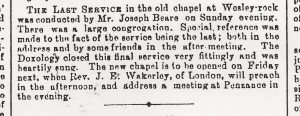 1898 The Cornishman 3rd March.
1898 The Cornishman 3rd March.
1898 The Cornishman Thursday 8th March. The new chapel was opened on the Friday…. The chapel was quite full and its seating capacity was tested to the utmost.
A license to hold marriages within the Chapel was obtained and people came from as far away as St Ives and St Just. License number 14977
1899 February. Henwood Roberts, ironmonger, was paid £20.7.0 for new oil lamps which were fitted in the chapel.
1899 The organ was installed and opened. It is believed that the organ was operated by waterpower when installed. The water was piped in on a two-inch pipe so it required a large amount of water. During the summer this was such a drain on the supply that they had to revert to pumping by hand. The organ was built by Messers Heard and Sons, Truro. The case stood out remarkably well and the fine row of front pipes gave an air of grandeur to this moderate sized instrument. The chapel was crowded at the recitals given in the afternoon and evening.
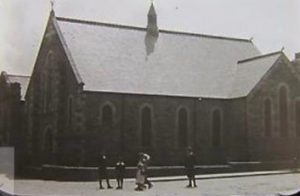 Image taken from an eBay site. C1900.
Image taken from an eBay site. C1900.
 1906 In the map above it can be seen that the Wesley Rock Chapel is now much bigger and fills the corner plot between Main Street and Rock Terrace. The village has now expanded towards Hea.
1906 In the map above it can be seen that the Wesley Rock Chapel is now much bigger and fills the corner plot between Main Street and Rock Terrace. The village has now expanded towards Hea.
1907 Heamoor Band requested the use of the Sunday school room for a concert. This was not granted as they wished to make a charge for entry. Because the building paid no rates no charge could be made, but a silver collection was taken when entertainment was put on.
1909 Trustees:
John Leggo, Rose Cottage Heamoor,
John Kemp White, farmer, Boscathnoe,
John Berriman, builder, 6, Main Street.
James Guy, Furniture dealer, He Cottage.
Richard Leggo, Yeoman, Richmond Street
John Jeffrey, farmer, Boscrowan
Benjamin Andrew, grocer’s traveller, Richmond Street
Richard Nichols, Bank Clerk, ‘Cyfartha’
Ernest Nichols, Teacher, ‘Cyfartha’
Francis Reginald Uren, Farmer, Trescrowan.
Edwin Angwin, Assistant overseer and collector. 3, Main Street.
1911 Mr Trevorrow replaced Mr. Baker as the Chapel cleaner or keeper. His wage was £15. per annum which increased to £17 in 1917.
1924 The chapel debt was discharged and the seats re-varnished.
1929 Electric lighting was installed at a cost of £96-5-0 by Meadows of Penzance: price to include a connection fee of £20.
1932 The chapel became Wesley Rock Methodist Church
1934 Heamoor was removed from the parish of Madron and included in Penzance: although Madron Feast is still celebrated in the village.
1935 Wesley Rock Sisterhood was formed in October 1935 with 71 members. The membership increased to 78 in 1936. A subscription membership was paid and there was a small charge for refreshments with the profits going to a sick fund for those in need due to ill health. Funds were also given to Methodist charities and local chapels.
1939 – 1945 No 4 vestry, being on the outside of the main building was taken over by the civil defence (A.R.P.) as the H.Q. for the village wardens. The iron railings and gates around the chapel buildings were removed to help with the war effort.
1942 Wednesday 13th May a Centenary Meeting was held in the original Chapel. (now the schoolroom).
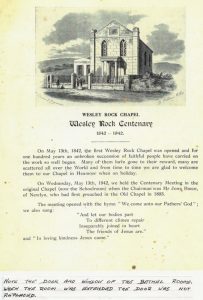 Image: Bill Dale
Image: Bill Dale
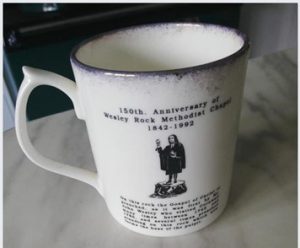
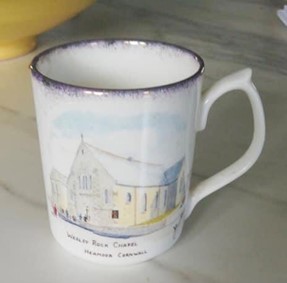 Images: Sue Griffin (nee Watson)
Images: Sue Griffin (nee Watson)
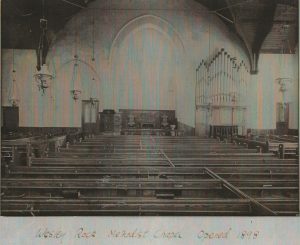 Image; Bill Dale
Image; Bill Dale
My Memories:
The door on the back left led into the old Chapel which was used as a Sunday school. To the right, the glazed door was the room the preachers used. Then to the right is the carved pulpit with the large stone underneath. The stone had to be made smaller to for the new pulpit and pieces of it were sold to raise money for the building fund. The altar is in the middle with the organ to the right. On the far right was the door to the choir waiting room, where the large pump handle to the organ was. This room could be accessed from outside and the room led to the choir stalls on the back right as you look at the photo. We had to pump the organ at times while waiting to go into the Church, which was hard work but we all wanted to do it! The lighting appears to be the oil lamps purchased in 1899.
To get to the Sunday School rooms you went out of the back left door and along an outside corridor which was slightly cut into the hill. Then you went into the back of the larger of the two other buildings. This has a direct link to the smaller building which was next to the private graveyard to which there was no access other than through the locked gate facing Rock Terrace.
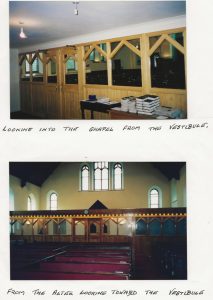 Images 1979
Images 1979
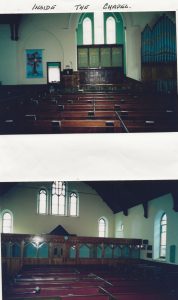 Note the Ten Commandments are now behind the altar and the lighting has now been changed from oil lamps.
Note the Ten Commandments are now behind the altar and the lighting has now been changed from oil lamps.
The date of 1979 on this photograph is possible too early and should be 1987 or later (Barry West)
The harvest supper is being held in the Schoolroom which was the original Wesley Rock chapel. The view above is towards the front doors which open onto Rock Terrace.
1996 It was decided to produce plans to bring the building up to date in-line with the new regulations. The necessary permission was obtained and finance arranged. The architect was Mr Cole of St Ives and the main contractor was Mr. Richards of Mousehole. Woodwork was carried out by Mr. Worledge of Regent Joinery, Penzance.
1997 Work commenced:
Alterations to access at the entrance to the chapel and school room. This made the steps obsolete and the entrance easy for disabled access.
The space between the original and new chapel was utilized to construct a building to house the new toilets and form an extra entrance to both buildings. Three toilets were built, one of which is for the disabled, and a shower.
In the chapel the rear pews were removed which made space for an entrance hall and a room where children can be accommodated, if necessary, during services in the chapel.
A separate appeal was launched to raise money to fund a new carpet for the chapel to match the new carpet laid in the entrance hall.
Sunday School Hall:
The old entrance doors are now used only as a fire exit. The entrance is now from the new extension between the two buildings. With the entrance hall removed there was enough length to install a bowling mat which is hoped will generate extra income.
The old toilets were demolished and new kitchens built on the site. These will comply with the new legislation and allow catering to be carried out.
£20,159 was raised towards this work in the first two years, which was half the necessary amount.
Images: Bill Dale
 The old schoolroom. Image: Timothy James
The old schoolroom. Image: Timothy James

 Plans for the upgrading of the Chapel and schoolroom
Plans for the upgrading of the Chapel and schoolroom
All photos and plans, unless otherwise stated, are in the file compiled by Bill Dale belonging to Val Thomas, his daughter.
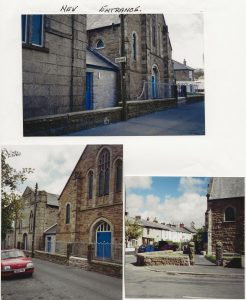
1997 New railings have now been made to enclose the original entrance to the Church.
The adjoining new link door can be seen.
Images: Methodist Churches on the internet, Newlyn Chapels.
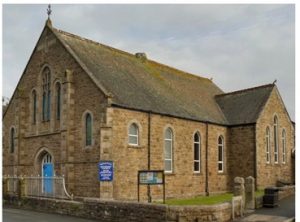

2016 The schoolroom was sold and receipts from the sale used to fund reordering of the chapel. The schoolroom is the two smaller buildings to the left of the large granite building which is the most commonly seen image.
2021 There is currently a membership of 45.
The sale of the older part of the Church
The older part of the Church, which is the two buildings between the Church and the private graveyard, have been turned into a private home called Rock Hall. It was for sale with Stacey Mann Estate agents in 2021: these are some of the sale photographs:
The old chapel front door has been reopened onto Rock Terrace.
The old Bethel room has been for-shortened to its original length to allow for a courtyard with a gate onto the road. It is now the kitchen/diner. The main Chapel now houses bedrooms, bathroom and lounge area.
Images: Stacey Mann Estate Agents
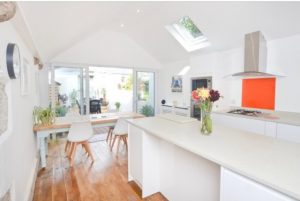
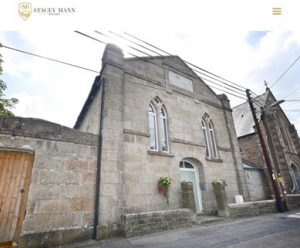

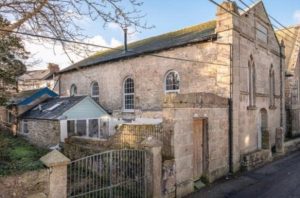 This image from the sales brochure shows the entrance to the private graveyard to the left, behind the gates. The original Sunday school room has been for-shortened to allow for a courtyard and the original window is now a gate. This also allows more light into the original Chapel building which was paid for by Mr Pengelly.
This image from the sales brochure shows the entrance to the private graveyard to the left, behind the gates. The original Sunday school room has been for-shortened to allow for a courtyard and the original window is now a gate. This also allows more light into the original Chapel building which was paid for by Mr Pengelly.
Kresen Kernow:
- Minutes, Leaders and Church Council. Wesley Rock Methodist Church, Heamoor, Madron 1926-1984 MRPZ/613
- Pulpit notices, Wesley Rock Methodist Chapel, Heamoor, Madron 1923-1928 – MRPZ/619
- Architect’s critique, builder’s work, new chapel, Wesley Rock Methodist Chapel, Heamoor, Madron. 29th September 1898 MRPZ/634
- Account, heating repairs, Wesley Rock Methodist Church, Heamoor, Madron 1st Dec 1942 MRPZ/645
- Account, grate bars, Sunday School, Wesley Rock Methodist Church, Heamoor, Madron 30th September 1942 MRPZ/643
- Inspection records, heating system, Wesley Rock Methodist Church, Heamoor, Madron. 1967-1970 MRPZ/648
- Typescript notes, John Wesley’s rock pulpit, Wesley Rock Methodist Chapel, Heamoor, Madron c1942 MRPZ/641
- Pulpit notices, Wesley Rock Methodist Chapel, Heamoor, Madron 1901-1902 MRPZ/616
- Pulpit notices, Wesley Rock Methodist Chapel, Heamoor, Madron 1899-1901 MRPZ/615
- Pulpit notices, Wesley Rock Methodist Chapel, Heamoor, Madron 1921-1923 MRPZ/618
- Lamp account, Wesley Rock Methodist Chapel, Heamoor, Madron Feb 1899 MRPZ/635
- Bazaar Accounts, Wesley Rock Methodist Chapel, Heamoor, Madron 7th Dec 1928 MRPZ/637
- Copy photograph, old chapel rostrum, Wesley Rock Methodist Chapel, Heamoor, Madron c1890 MRPZ60
- Printed account. Centenary celebrations, Wesley Rock Methodist Chapel, Heamoor, Madron 13th May 1942 MRPZ/639
- Approval of scheme, Wesley Rock Methodist Church 19th June 1969, Heamoor, Madron
- Letter, organ overhaul and cleaning, Wesley Rock Methodist Church, Heamoor, Madron 6th April 1954 MRPZ/647/1
- Pulpit notices, Wesley Rock Methodist Church, Heamoor, Madron 1965-1966 MRPZ/622
- Pulpit notices, Wesley Rock Methodist Church, Heamoor, Madron1974-1975
etc ….
Resources:
Bill Dale’s Wesley Rock file which was compiled with the assistance of John and Francis Uren, Mrs. Tonkin and Maureen Worledge, Mr Cargeeg and Mrs Lilly Allen
Wikipedia – en.wikipedia.org
National maps of Scotland.
thecentrenewlyn.org
Stacey Mann Estate agents
Google images.
Facebook – Nostalgic Penzance and Newlyn
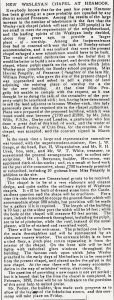 Opening of the chapel 1897 (Cornishman 20th May 1897)
Opening of the chapel 1897 (Cornishman 20th May 1897)
The following photographs are by Barry West
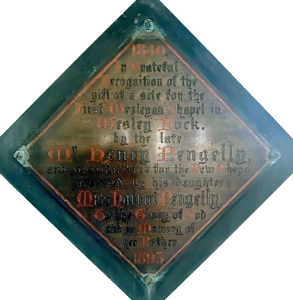
Brass plaque states “1840 In grateful recognition of the gift of the site for the first Wesleyan Chapel In Wesley Rock By the late mr Henry Pengelly and also for land for the new Chapel presented by his daughter Miss Harriet Pengelly To the Glory of God and in memory of her Father 1893”

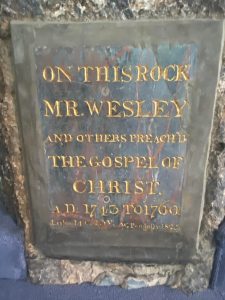

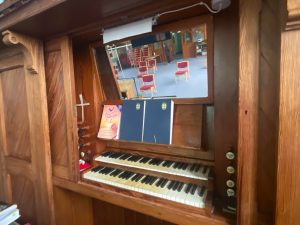
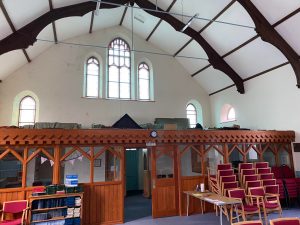
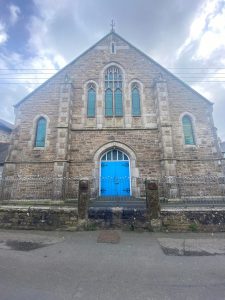

I have been a member of Wesley Rock since 1983. Thank you for this information. The harvest supper is dated 1979 – this cannot be correct – it’s post 1986. The photos which have been taken from the website were taken by my husband, Godfrey Stevens.
Thank you Mrs Stevens. Dad did make occasional mistakes. Your husband, Godfrey, was wonderful to Mum and Dad and I will always be grateful for the time he spent organising tv’s etc for them.
Hi,
Are you able to tell me when the Rev Charles Brown was minister at Wesley Rock?
Just read your reply.
It’s very easy to get dates wrong
It was my husband’s brother who mended TVs.
Best wishes
I’ll ask around. Have you any idea of the date, please?
Many thanks